Face Recognition: Literature Review, Techniques, and Future Scope
VerifiedAdded on 2021/09/21
|16
|3863
|264
Report
AI Summary
This report provides a comprehensive literature review of face recognition systems. It begins with an introduction to face recognition, defining its capabilities and applications, such as video surveillance, human-computer interaction, and access control. The report then delves into various techniques e...

Running head: FACE RECOGNITION
Face Recognition
Name of the Student
Name of the University
Author’s Note:
Face Recognition
Name of the Student
Name of the University
Author’s Note:
Paraphrase This Document
Need a fresh take? Get an instant paraphrase of this document with our AI Paraphraser
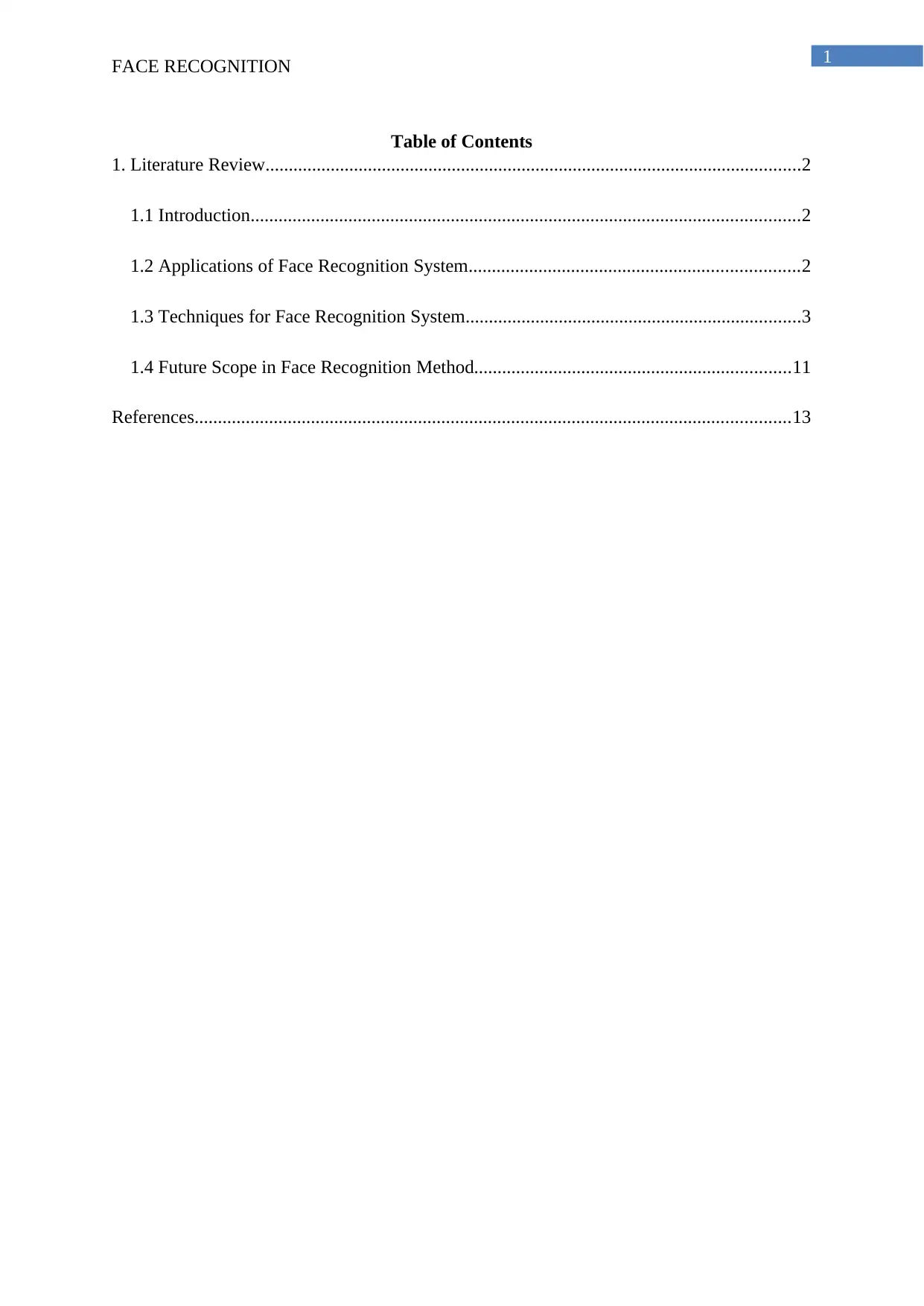
1
FACE RECOGNITION
Table of Contents
1. Literature Review...................................................................................................................2
1.1 Introduction......................................................................................................................2
1.2 Applications of Face Recognition System.......................................................................2
1.3 Techniques for Face Recognition System........................................................................3
1.4 Future Scope in Face Recognition Method....................................................................11
References................................................................................................................................13
FACE RECOGNITION
Table of Contents
1. Literature Review...................................................................................................................2
1.1 Introduction......................................................................................................................2
1.2 Applications of Face Recognition System.......................................................................2
1.3 Techniques for Face Recognition System........................................................................3
1.4 Future Scope in Face Recognition Method....................................................................11
References................................................................................................................................13
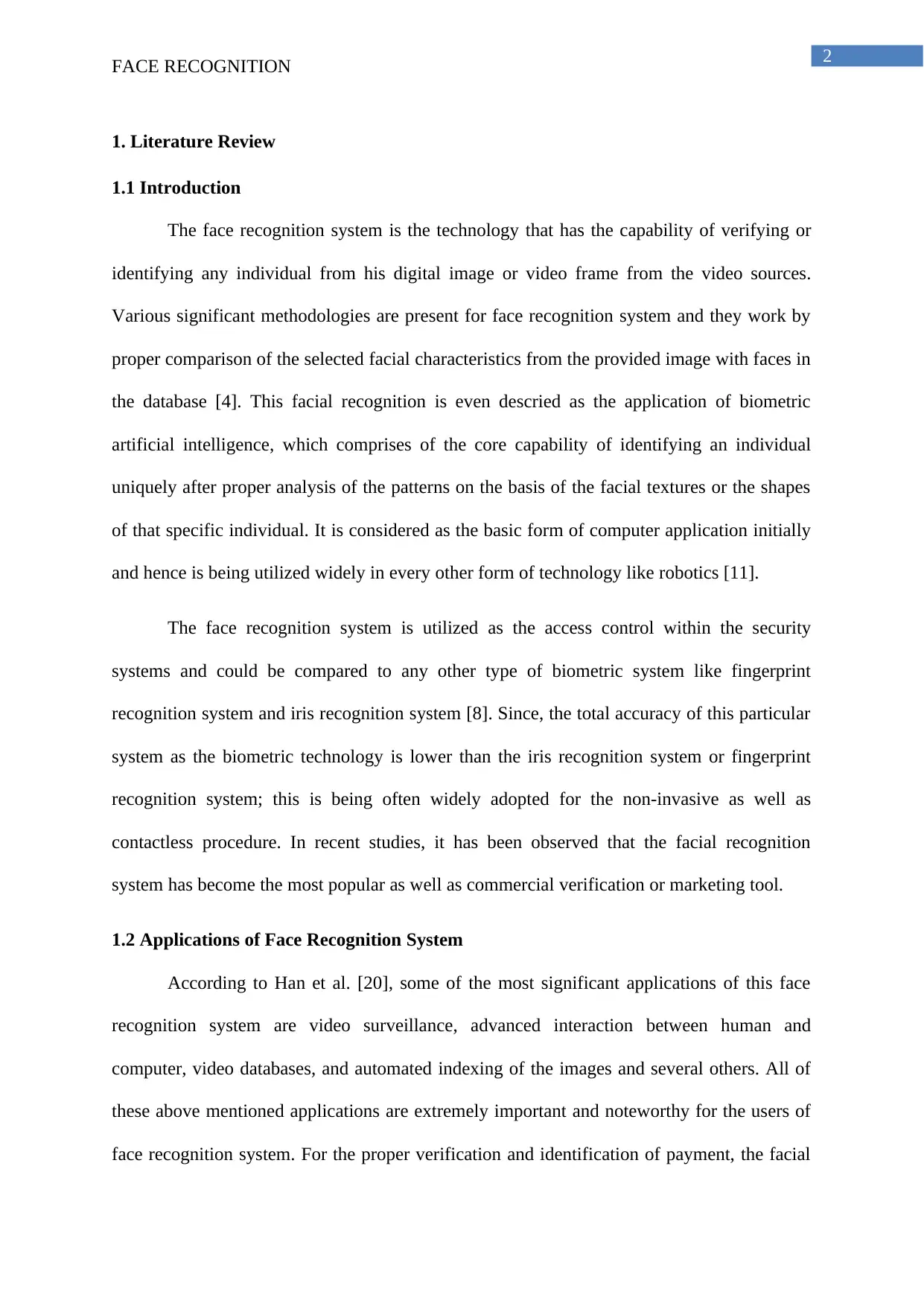
2
FACE RECOGNITION
1. Literature Review
1.1 Introduction
The face recognition system is the technology that has the capability of verifying or
identifying any individual from his digital image or video frame from the video sources.
Various significant methodologies are present for face recognition system and they work by
proper comparison of the selected facial characteristics from the provided image with faces in
the database [4]. This facial recognition is even descried as the application of biometric
artificial intelligence, which comprises of the core capability of identifying an individual
uniquely after proper analysis of the patterns on the basis of the facial textures or the shapes
of that specific individual. It is considered as the basic form of computer application initially
and hence is being utilized widely in every other form of technology like robotics [11].
The face recognition system is utilized as the access control within the security
systems and could be compared to any other type of biometric system like fingerprint
recognition system and iris recognition system [8]. Since, the total accuracy of this particular
system as the biometric technology is lower than the iris recognition system or fingerprint
recognition system; this is being often widely adopted for the non-invasive as well as
contactless procedure. In recent studies, it has been observed that the facial recognition
system has become the most popular as well as commercial verification or marketing tool.
1.2 Applications of Face Recognition System
According to Han et al. [20], some of the most significant applications of this face
recognition system are video surveillance, advanced interaction between human and
computer, video databases, and automated indexing of the images and several others. All of
these above mentioned applications are extremely important and noteworthy for the users of
face recognition system. For the proper verification and identification of payment, the facial
FACE RECOGNITION
1. Literature Review
1.1 Introduction
The face recognition system is the technology that has the capability of verifying or
identifying any individual from his digital image or video frame from the video sources.
Various significant methodologies are present for face recognition system and they work by
proper comparison of the selected facial characteristics from the provided image with faces in
the database [4]. This facial recognition is even descried as the application of biometric
artificial intelligence, which comprises of the core capability of identifying an individual
uniquely after proper analysis of the patterns on the basis of the facial textures or the shapes
of that specific individual. It is considered as the basic form of computer application initially
and hence is being utilized widely in every other form of technology like robotics [11].
The face recognition system is utilized as the access control within the security
systems and could be compared to any other type of biometric system like fingerprint
recognition system and iris recognition system [8]. Since, the total accuracy of this particular
system as the biometric technology is lower than the iris recognition system or fingerprint
recognition system; this is being often widely adopted for the non-invasive as well as
contactless procedure. In recent studies, it has been observed that the facial recognition
system has become the most popular as well as commercial verification or marketing tool.
1.2 Applications of Face Recognition System
According to Han et al. [20], some of the most significant applications of this face
recognition system are video surveillance, advanced interaction between human and
computer, video databases, and automated indexing of the images and several others. All of
these above mentioned applications are extremely important and noteworthy for the users of
face recognition system. For the proper verification and identification of payment, the facial
⊘ This is a preview!⊘
Do you want full access?
Subscribe today to unlock all pages.

Trusted by 1+ million students worldwide

3
FACE RECOGNITION
biometrics could be integrated with all the physical devices or objects [10]. With the
subsequent utilization of passcodes, the mobile phones and other customer electronics could
be easily accessed with the facial features of the owners for making payments. Moreover,
criminal identification is also easier with this particular system. Other applications of face
recognition system mainly include advertising, health care and many others.
Figure 1: Block Diagram of Face Recognition System
(Source: Haig [5])
1.3 Techniques for Face Recognition System
Parkhi, Andrea and Andrew [2], state that the entire procedure of the face recognition
method could be performed in two distinct steps. The first and the foremost step of this
system includes the feature extraction as well as feature selection. The second step in this
system includes the proper classification of the objects. The recent developments have been
introduced by varying the technologies to this process of face recognition. Some of the major
and the most notable techniques of the face recognition system are as follows:
FACE RECOGNITION
biometrics could be integrated with all the physical devices or objects [10]. With the
subsequent utilization of passcodes, the mobile phones and other customer electronics could
be easily accessed with the facial features of the owners for making payments. Moreover,
criminal identification is also easier with this particular system. Other applications of face
recognition system mainly include advertising, health care and many others.
Figure 1: Block Diagram of Face Recognition System
(Source: Haig [5])
1.3 Techniques for Face Recognition System
Parkhi, Andrea and Andrew [2], state that the entire procedure of the face recognition
method could be performed in two distinct steps. The first and the foremost step of this
system includes the feature extraction as well as feature selection. The second step in this
system includes the proper classification of the objects. The recent developments have been
introduced by varying the technologies to this process of face recognition. Some of the major
and the most notable techniques of the face recognition system are as follows:
Paraphrase This Document
Need a fresh take? Get an instant paraphrase of this document with our AI Paraphraser

4
FACE RECOGNITION
i) Traditional Technique: Few of the algorithms of this face recognition system help
in the identification of the facial features of the individual by simply extracting the features or
landmarks from the image of that specific individual’s face [9]. As an example, the algorithm
could analyse the relative positions, shapes and sizes of the nose, eyes, jaws and cheek bones.
Each and every above mentioned feature is then utilized for the purpose of searching the
other images with the help of the matching features. The other important algorithms
eventually normalize the entire gallery of the face images as well as compressing the facial
data and hence saving that data within the image, which could be utilized for the purpose of
face recognition [13]. A specific probe image is next subsequently compared with the
collected facial data. The earliest and the most successful system is thus based on the several
techniques of template matching and is being applied to the collection of the important facial
features. A sort of the respective compacted face representation is provided in this manner.
As per Cui et al. [12], the recognition algorithms hence could be sub divided into two
major approaches, known as the geometric or checking the distinguishing characteristics and
the photometric; a specified statistical approach, which is responsible for distilling any image
into reasonable values and then comparing these values with the various templates for the
core purpose of eliminating the variances. Most of these algorithms could be properly
classified into two broader categories like holistic model and feature based model [15]. The
holistic model attempts in recognizing the face in the entirely and the feature based model
can sub divide these elements like as per the features and analysis of each of the feature in
comparison to any other feature. The most popular algorithms of the face recognition system
are linear discriminant analyses, hidden Markov model, principal component analyses with
eigen faces, dynamic link matching, multi linear subspace learning with tensor representation,
Fisher face algorithm and various others [19].
FACE RECOGNITION
i) Traditional Technique: Few of the algorithms of this face recognition system help
in the identification of the facial features of the individual by simply extracting the features or
landmarks from the image of that specific individual’s face [9]. As an example, the algorithm
could analyse the relative positions, shapes and sizes of the nose, eyes, jaws and cheek bones.
Each and every above mentioned feature is then utilized for the purpose of searching the
other images with the help of the matching features. The other important algorithms
eventually normalize the entire gallery of the face images as well as compressing the facial
data and hence saving that data within the image, which could be utilized for the purpose of
face recognition [13]. A specific probe image is next subsequently compared with the
collected facial data. The earliest and the most successful system is thus based on the several
techniques of template matching and is being applied to the collection of the important facial
features. A sort of the respective compacted face representation is provided in this manner.
As per Cui et al. [12], the recognition algorithms hence could be sub divided into two
major approaches, known as the geometric or checking the distinguishing characteristics and
the photometric; a specified statistical approach, which is responsible for distilling any image
into reasonable values and then comparing these values with the various templates for the
core purpose of eliminating the variances. Most of these algorithms could be properly
classified into two broader categories like holistic model and feature based model [15]. The
holistic model attempts in recognizing the face in the entirely and the feature based model
can sub divide these elements like as per the features and analysis of each of the feature in
comparison to any other feature. The most popular algorithms of the face recognition system
are linear discriminant analyses, hidden Markov model, principal component analyses with
eigen faces, dynamic link matching, multi linear subspace learning with tensor representation,
Fisher face algorithm and various others [19].

5
FACE RECOGNITION
Figure 2: Process of Video Based Face Recognition System
(Source: Chan et al. [18])
ii) 3 Dimensional Recognition Technique: Drira et al. [9] state that this particular
technique of face recognition is majorly responsible for utilizing the 3D sensors to eventually
capture the information regarding the distinct shape of the face of an individual. This specific
information is afterwards utilized for the purpose of utilizing to identify and verify the
distinct characteristics on the face surface like contouring of eye sockets, chin and nose. The
major benefit of the 3D face recognition system would be that this is not at all affected by the
various changes or alterations within lighting similar to other techniques. This technique
could even identify any face from the range of overviewing angles involving the profile view.
The respective three dimensional data points from the face substantially improvises the
overall precision of the face recognition. As per a recent research of Amos, Bartosz and
Mahadev [14], the three dimensional system is being enhanced by properly developing the
FACE RECOGNITION
Figure 2: Process of Video Based Face Recognition System
(Source: Chan et al. [18])
ii) 3 Dimensional Recognition Technique: Drira et al. [9] state that this particular
technique of face recognition is majorly responsible for utilizing the 3D sensors to eventually
capture the information regarding the distinct shape of the face of an individual. This specific
information is afterwards utilized for the purpose of utilizing to identify and verify the
distinct characteristics on the face surface like contouring of eye sockets, chin and nose. The
major benefit of the 3D face recognition system would be that this is not at all affected by the
various changes or alterations within lighting similar to other techniques. This technique
could even identify any face from the range of overviewing angles involving the profile view.
The respective three dimensional data points from the face substantially improvises the
overall precision of the face recognition. As per a recent research of Amos, Bartosz and
Mahadev [14], the three dimensional system is being enhanced by properly developing the
⊘ This is a preview!⊘
Do you want full access?
Subscribe today to unlock all pages.

Trusted by 1+ million students worldwide
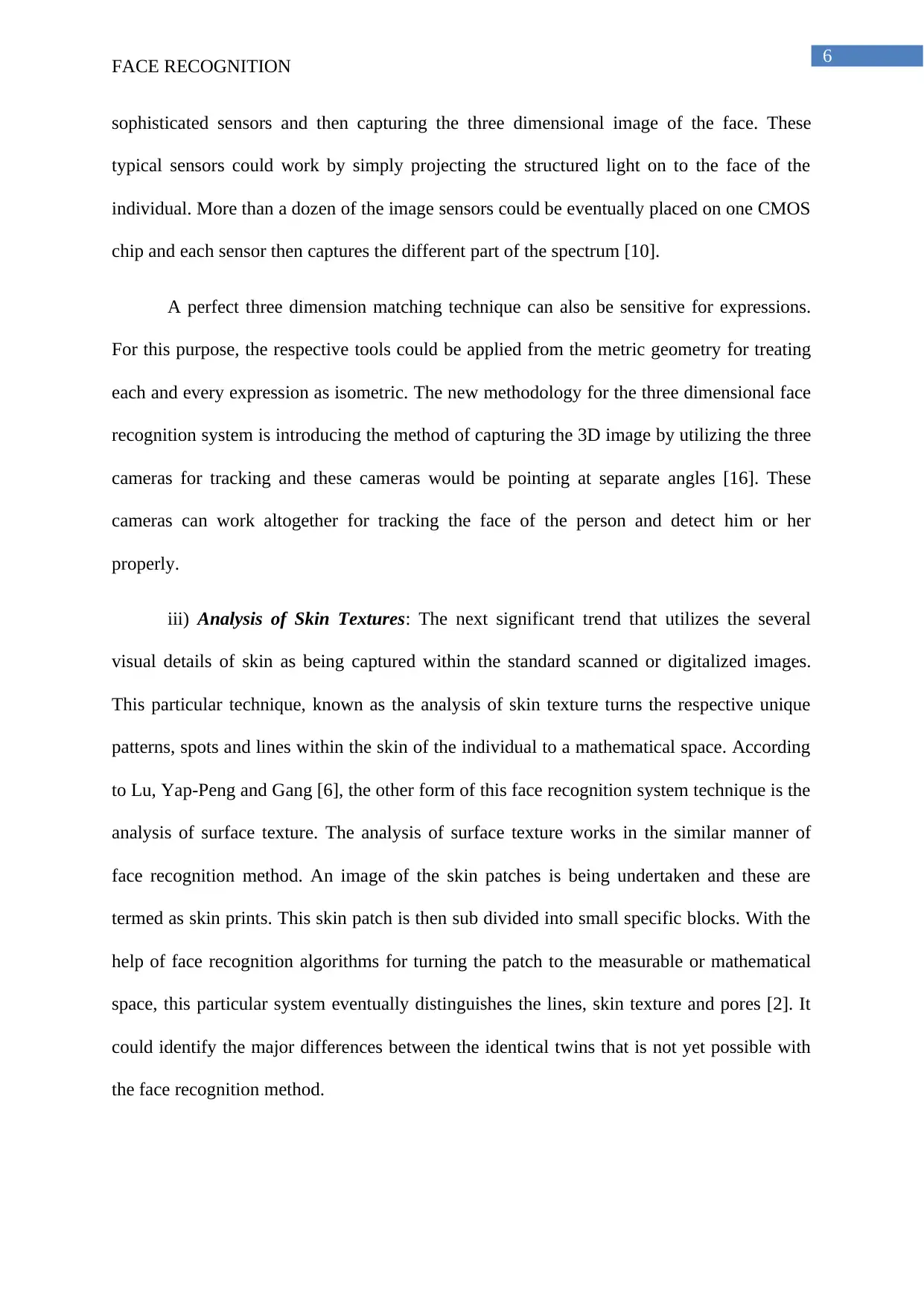
6
FACE RECOGNITION
sophisticated sensors and then capturing the three dimensional image of the face. These
typical sensors could work by simply projecting the structured light on to the face of the
individual. More than a dozen of the image sensors could be eventually placed on one CMOS
chip and each sensor then captures the different part of the spectrum [10].
A perfect three dimension matching technique can also be sensitive for expressions.
For this purpose, the respective tools could be applied from the metric geometry for treating
each and every expression as isometric. The new methodology for the three dimensional face
recognition system is introducing the method of capturing the 3D image by utilizing the three
cameras for tracking and these cameras would be pointing at separate angles [16]. These
cameras can work altogether for tracking the face of the person and detect him or her
properly.
iii) Analysis of Skin Textures: The next significant trend that utilizes the several
visual details of skin as being captured within the standard scanned or digitalized images.
This particular technique, known as the analysis of skin texture turns the respective unique
patterns, spots and lines within the skin of the individual to a mathematical space. According
to Lu, Yap-Peng and Gang [6], the other form of this face recognition system technique is the
analysis of surface texture. The analysis of surface texture works in the similar manner of
face recognition method. An image of the skin patches is being undertaken and these are
termed as skin prints. This skin patch is then sub divided into small specific blocks. With the
help of face recognition algorithms for turning the patch to the measurable or mathematical
space, this particular system eventually distinguishes the lines, skin texture and pores [2]. It
could identify the major differences between the identical twins that is not yet possible with
the face recognition method.
FACE RECOGNITION
sophisticated sensors and then capturing the three dimensional image of the face. These
typical sensors could work by simply projecting the structured light on to the face of the
individual. More than a dozen of the image sensors could be eventually placed on one CMOS
chip and each sensor then captures the different part of the spectrum [10].
A perfect three dimension matching technique can also be sensitive for expressions.
For this purpose, the respective tools could be applied from the metric geometry for treating
each and every expression as isometric. The new methodology for the three dimensional face
recognition system is introducing the method of capturing the 3D image by utilizing the three
cameras for tracking and these cameras would be pointing at separate angles [16]. These
cameras can work altogether for tracking the face of the person and detect him or her
properly.
iii) Analysis of Skin Textures: The next significant trend that utilizes the several
visual details of skin as being captured within the standard scanned or digitalized images.
This particular technique, known as the analysis of skin texture turns the respective unique
patterns, spots and lines within the skin of the individual to a mathematical space. According
to Lu, Yap-Peng and Gang [6], the other form of this face recognition system technique is the
analysis of surface texture. The analysis of surface texture works in the similar manner of
face recognition method. An image of the skin patches is being undertaken and these are
termed as skin prints. This skin patch is then sub divided into small specific blocks. With the
help of face recognition algorithms for turning the patch to the measurable or mathematical
space, this particular system eventually distinguishes the lines, skin texture and pores [2]. It
could identify the major differences between the identical twins that is not yet possible with
the face recognition method.
Paraphrase This Document
Need a fresh take? Get an instant paraphrase of this document with our AI Paraphraser
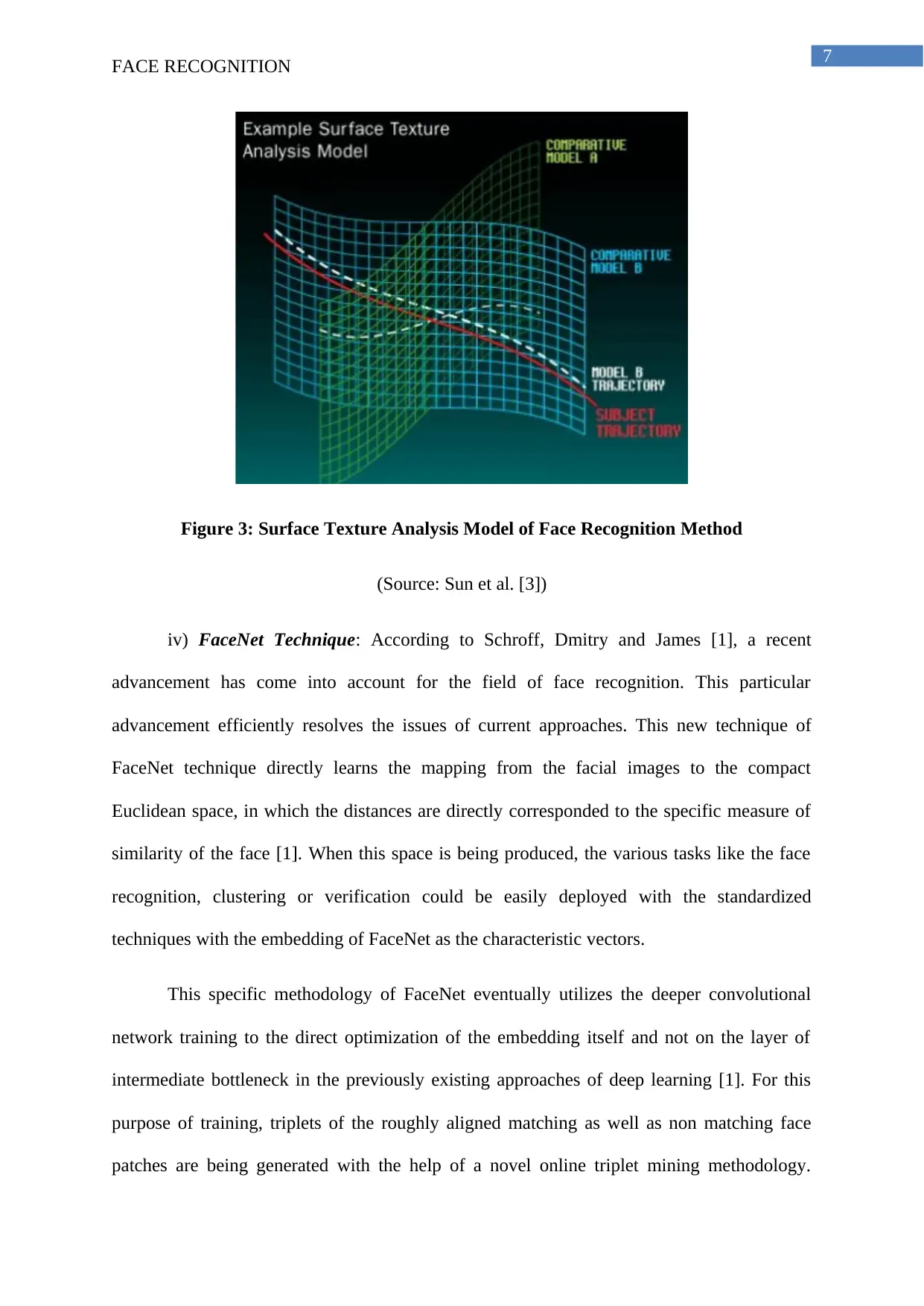
7
FACE RECOGNITION
Figure 3: Surface Texture Analysis Model of Face Recognition Method
(Source: Sun et al. [3])
iv) FaceNet Technique: According to Schroff, Dmitry and James [1], a recent
advancement has come into account for the field of face recognition. This particular
advancement efficiently resolves the issues of current approaches. This new technique of
FaceNet technique directly learns the mapping from the facial images to the compact
Euclidean space, in which the distances are directly corresponded to the specific measure of
similarity of the face [1]. When this space is being produced, the various tasks like the face
recognition, clustering or verification could be easily deployed with the standardized
techniques with the embedding of FaceNet as the characteristic vectors.
This specific methodology of FaceNet eventually utilizes the deeper convolutional
network training to the direct optimization of the embedding itself and not on the layer of
intermediate bottleneck in the previously existing approaches of deep learning [1]. For this
purpose of training, triplets of the roughly aligned matching as well as non matching face
patches are being generated with the help of a novel online triplet mining methodology.
FACE RECOGNITION
Figure 3: Surface Texture Analysis Model of Face Recognition Method
(Source: Sun et al. [3])
iv) FaceNet Technique: According to Schroff, Dmitry and James [1], a recent
advancement has come into account for the field of face recognition. This particular
advancement efficiently resolves the issues of current approaches. This new technique of
FaceNet technique directly learns the mapping from the facial images to the compact
Euclidean space, in which the distances are directly corresponded to the specific measure of
similarity of the face [1]. When this space is being produced, the various tasks like the face
recognition, clustering or verification could be easily deployed with the standardized
techniques with the embedding of FaceNet as the characteristic vectors.
This specific methodology of FaceNet eventually utilizes the deeper convolutional
network training to the direct optimization of the embedding itself and not on the layer of
intermediate bottleneck in the previously existing approaches of deep learning [1]. For this
purpose of training, triplets of the roughly aligned matching as well as non matching face
patches are being generated with the help of a novel online triplet mining methodology.
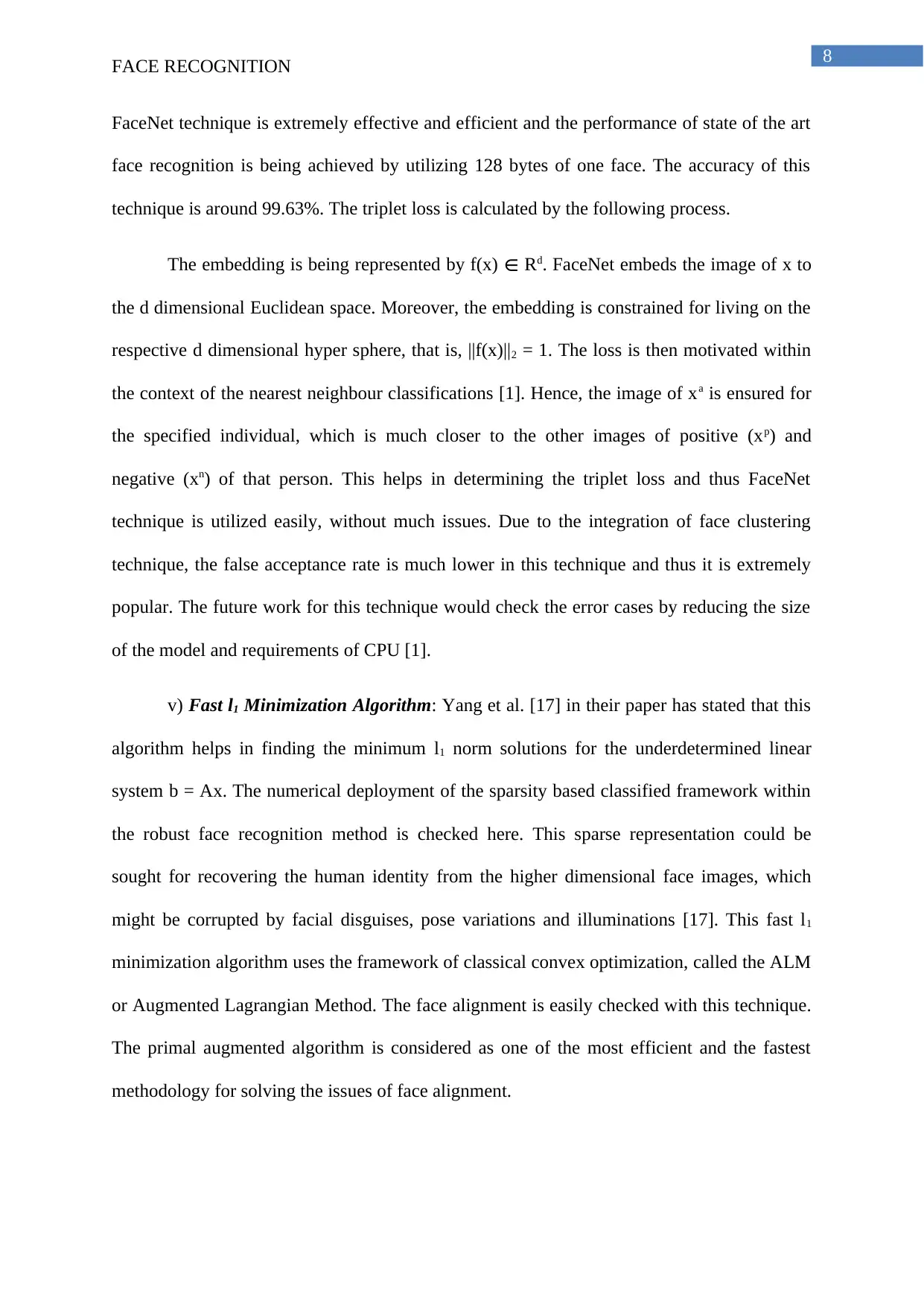
8
FACE RECOGNITION
FaceNet technique is extremely effective and efficient and the performance of state of the art
face recognition is being achieved by utilizing 128 bytes of one face. The accuracy of this
technique is around 99.63%. The triplet loss is calculated by the following process.
The embedding is being represented by f(x) ∈ Rd. FaceNet embeds the image of x to
the d dimensional Euclidean space. Moreover, the embedding is constrained for living on the
respective d dimensional hyper sphere, that is, ||f(x)||2 = 1. The loss is then motivated within
the context of the nearest neighbour classifications [1]. Hence, the image of xa is ensured for
the specified individual, which is much closer to the other images of positive (xp) and
negative (xn) of that person. This helps in determining the triplet loss and thus FaceNet
technique is utilized easily, without much issues. Due to the integration of face clustering
technique, the false acceptance rate is much lower in this technique and thus it is extremely
popular. The future work for this technique would check the error cases by reducing the size
of the model and requirements of CPU [1].
v) Fast l1 Minimization Algorithm: Yang et al. [17] in their paper has stated that this
algorithm helps in finding the minimum l1 norm solutions for the underdetermined linear
system b = Ax. The numerical deployment of the sparsity based classified framework within
the robust face recognition method is checked here. This sparse representation could be
sought for recovering the human identity from the higher dimensional face images, which
might be corrupted by facial disguises, pose variations and illuminations [17]. This fast l1
minimization algorithm uses the framework of classical convex optimization, called the ALM
or Augmented Lagrangian Method. The face alignment is easily checked with this technique.
The primal augmented algorithm is considered as one of the most efficient and the fastest
methodology for solving the issues of face alignment.
FACE RECOGNITION
FaceNet technique is extremely effective and efficient and the performance of state of the art
face recognition is being achieved by utilizing 128 bytes of one face. The accuracy of this
technique is around 99.63%. The triplet loss is calculated by the following process.
The embedding is being represented by f(x) ∈ Rd. FaceNet embeds the image of x to
the d dimensional Euclidean space. Moreover, the embedding is constrained for living on the
respective d dimensional hyper sphere, that is, ||f(x)||2 = 1. The loss is then motivated within
the context of the nearest neighbour classifications [1]. Hence, the image of xa is ensured for
the specified individual, which is much closer to the other images of positive (xp) and
negative (xn) of that person. This helps in determining the triplet loss and thus FaceNet
technique is utilized easily, without much issues. Due to the integration of face clustering
technique, the false acceptance rate is much lower in this technique and thus it is extremely
popular. The future work for this technique would check the error cases by reducing the size
of the model and requirements of CPU [1].
v) Fast l1 Minimization Algorithm: Yang et al. [17] in their paper has stated that this
algorithm helps in finding the minimum l1 norm solutions for the underdetermined linear
system b = Ax. The numerical deployment of the sparsity based classified framework within
the robust face recognition method is checked here. This sparse representation could be
sought for recovering the human identity from the higher dimensional face images, which
might be corrupted by facial disguises, pose variations and illuminations [17]. This fast l1
minimization algorithm uses the framework of classical convex optimization, called the ALM
or Augmented Lagrangian Method. The face alignment is easily checked with this technique.
The primal augmented algorithm is considered as one of the most efficient and the fastest
methodology for solving the issues of face alignment.
⊘ This is a preview!⊘
Do you want full access?
Subscribe today to unlock all pages.

Trusted by 1+ million students worldwide
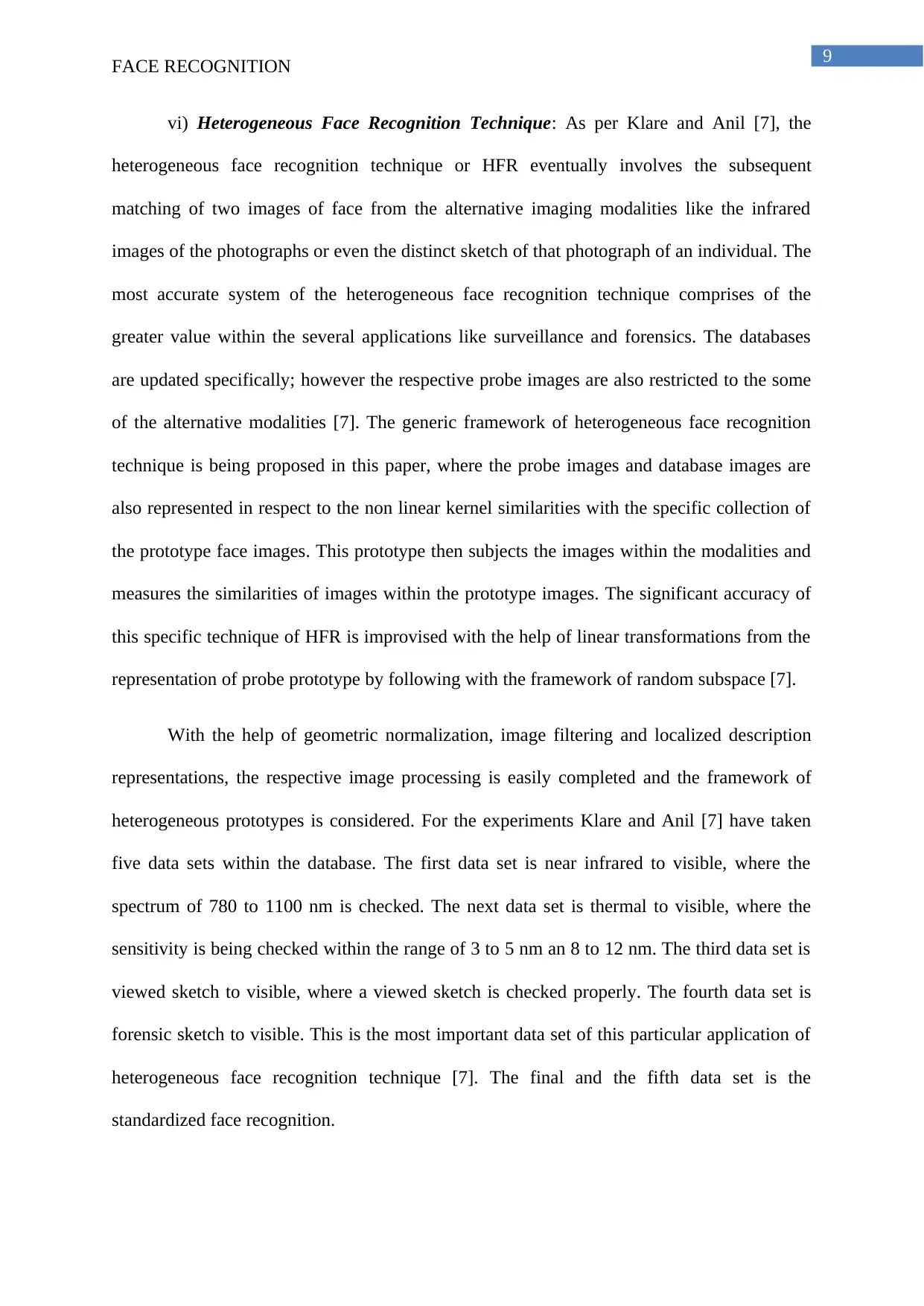
9
FACE RECOGNITION
vi) Heterogeneous Face Recognition Technique: As per Klare and Anil [7], the
heterogeneous face recognition technique or HFR eventually involves the subsequent
matching of two images of face from the alternative imaging modalities like the infrared
images of the photographs or even the distinct sketch of that photograph of an individual. The
most accurate system of the heterogeneous face recognition technique comprises of the
greater value within the several applications like surveillance and forensics. The databases
are updated specifically; however the respective probe images are also restricted to the some
of the alternative modalities [7]. The generic framework of heterogeneous face recognition
technique is being proposed in this paper, where the probe images and database images are
also represented in respect to the non linear kernel similarities with the specific collection of
the prototype face images. This prototype then subjects the images within the modalities and
measures the similarities of images within the prototype images. The significant accuracy of
this specific technique of HFR is improvised with the help of linear transformations from the
representation of probe prototype by following with the framework of random subspace [7].
With the help of geometric normalization, image filtering and localized description
representations, the respective image processing is easily completed and the framework of
heterogeneous prototypes is considered. For the experiments Klare and Anil [7] have taken
five data sets within the database. The first data set is near infrared to visible, where the
spectrum of 780 to 1100 nm is checked. The next data set is thermal to visible, where the
sensitivity is being checked within the range of 3 to 5 nm an 8 to 12 nm. The third data set is
viewed sketch to visible, where a viewed sketch is checked properly. The fourth data set is
forensic sketch to visible. This is the most important data set of this particular application of
heterogeneous face recognition technique [7]. The final and the fifth data set is the
standardized face recognition.
FACE RECOGNITION
vi) Heterogeneous Face Recognition Technique: As per Klare and Anil [7], the
heterogeneous face recognition technique or HFR eventually involves the subsequent
matching of two images of face from the alternative imaging modalities like the infrared
images of the photographs or even the distinct sketch of that photograph of an individual. The
most accurate system of the heterogeneous face recognition technique comprises of the
greater value within the several applications like surveillance and forensics. The databases
are updated specifically; however the respective probe images are also restricted to the some
of the alternative modalities [7]. The generic framework of heterogeneous face recognition
technique is being proposed in this paper, where the probe images and database images are
also represented in respect to the non linear kernel similarities with the specific collection of
the prototype face images. This prototype then subjects the images within the modalities and
measures the similarities of images within the prototype images. The significant accuracy of
this specific technique of HFR is improvised with the help of linear transformations from the
representation of probe prototype by following with the framework of random subspace [7].
With the help of geometric normalization, image filtering and localized description
representations, the respective image processing is easily completed and the framework of
heterogeneous prototypes is considered. For the experiments Klare and Anil [7] have taken
five data sets within the database. The first data set is near infrared to visible, where the
spectrum of 780 to 1100 nm is checked. The next data set is thermal to visible, where the
sensitivity is being checked within the range of 3 to 5 nm an 8 to 12 nm. The third data set is
viewed sketch to visible, where a viewed sketch is checked properly. The fourth data set is
forensic sketch to visible. This is the most important data set of this particular application of
heterogeneous face recognition technique [7]. The final and the fifth data set is the
standardized face recognition.
Paraphrase This Document
Need a fresh take? Get an instant paraphrase of this document with our AI Paraphraser
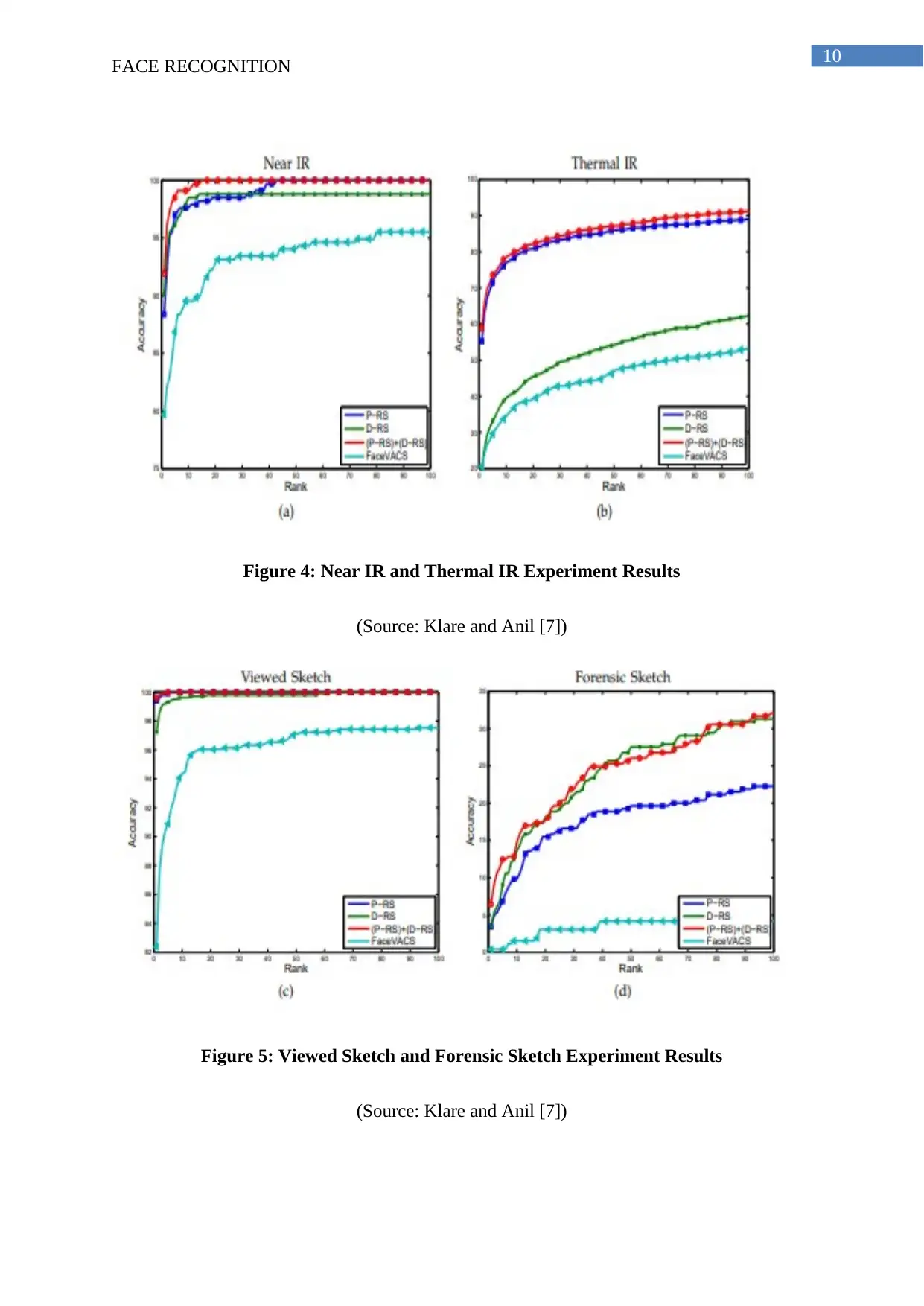
10
FACE RECOGNITION
Figure 4: Near IR and Thermal IR Experiment Results
(Source: Klare and Anil [7])
Figure 5: Viewed Sketch and Forensic Sketch Experiment Results
(Source: Klare and Anil [7])
FACE RECOGNITION
Figure 4: Near IR and Thermal IR Experiment Results
(Source: Klare and Anil [7])
Figure 5: Viewed Sketch and Forensic Sketch Experiment Results
(Source: Klare and Anil [7])
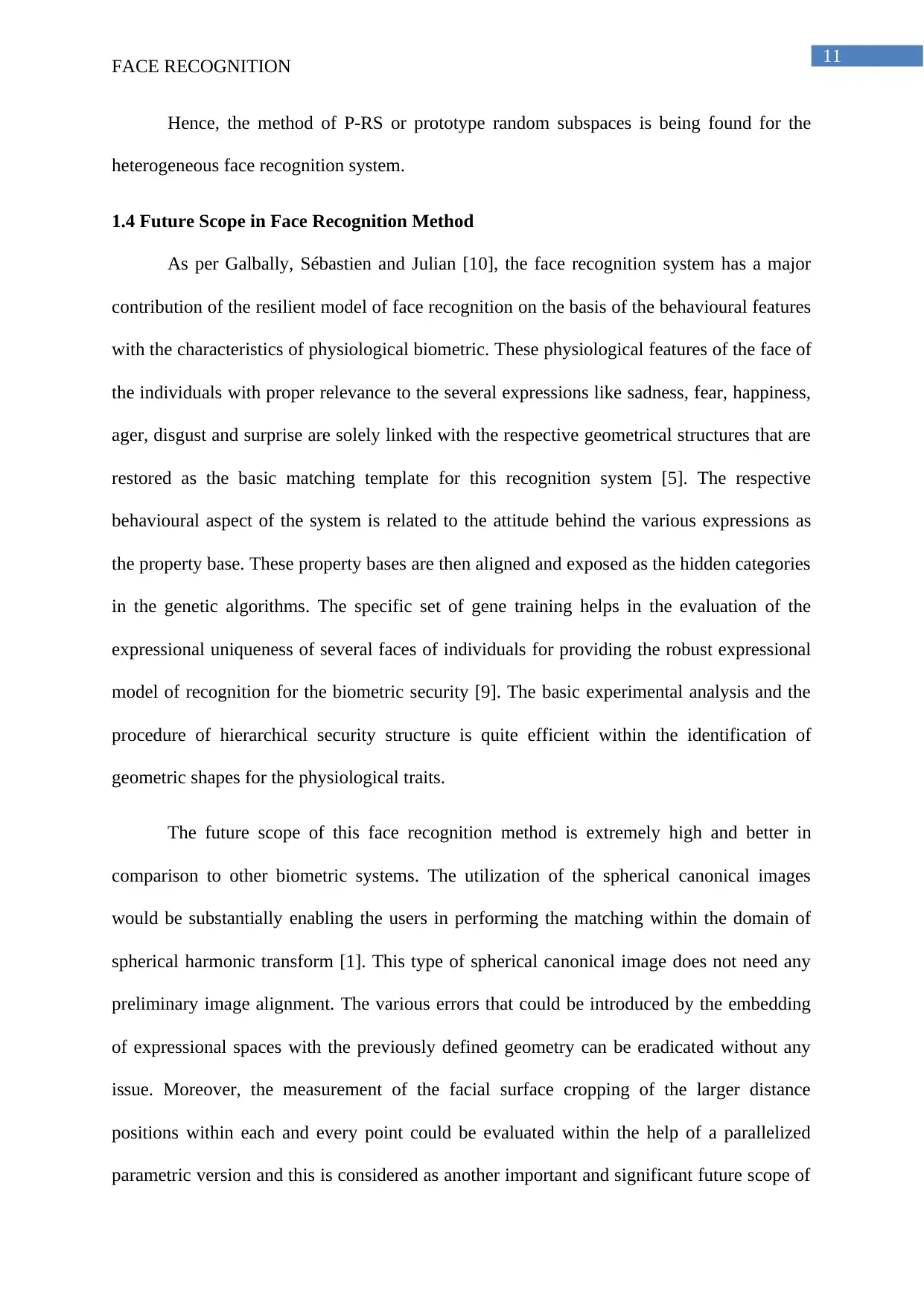
11
FACE RECOGNITION
Hence, the method of P-RS or prototype random subspaces is being found for the
heterogeneous face recognition system.
1.4 Future Scope in Face Recognition Method
As per Galbally, Sébastien and Julian [10], the face recognition system has a major
contribution of the resilient model of face recognition on the basis of the behavioural features
with the characteristics of physiological biometric. These physiological features of the face of
the individuals with proper relevance to the several expressions like sadness, fear, happiness,
ager, disgust and surprise are solely linked with the respective geometrical structures that are
restored as the basic matching template for this recognition system [5]. The respective
behavioural aspect of the system is related to the attitude behind the various expressions as
the property base. These property bases are then aligned and exposed as the hidden categories
in the genetic algorithms. The specific set of gene training helps in the evaluation of the
expressional uniqueness of several faces of individuals for providing the robust expressional
model of recognition for the biometric security [9]. The basic experimental analysis and the
procedure of hierarchical security structure is quite efficient within the identification of
geometric shapes for the physiological traits.
The future scope of this face recognition method is extremely high and better in
comparison to other biometric systems. The utilization of the spherical canonical images
would be substantially enabling the users in performing the matching within the domain of
spherical harmonic transform [1]. This type of spherical canonical image does not need any
preliminary image alignment. The various errors that could be introduced by the embedding
of expressional spaces with the previously defined geometry can be eradicated without any
issue. Moreover, the measurement of the facial surface cropping of the larger distance
positions within each and every point could be evaluated within the help of a parallelized
parametric version and this is considered as another important and significant future scope of
FACE RECOGNITION
Hence, the method of P-RS or prototype random subspaces is being found for the
heterogeneous face recognition system.
1.4 Future Scope in Face Recognition Method
As per Galbally, Sébastien and Julian [10], the face recognition system has a major
contribution of the resilient model of face recognition on the basis of the behavioural features
with the characteristics of physiological biometric. These physiological features of the face of
the individuals with proper relevance to the several expressions like sadness, fear, happiness,
ager, disgust and surprise are solely linked with the respective geometrical structures that are
restored as the basic matching template for this recognition system [5]. The respective
behavioural aspect of the system is related to the attitude behind the various expressions as
the property base. These property bases are then aligned and exposed as the hidden categories
in the genetic algorithms. The specific set of gene training helps in the evaluation of the
expressional uniqueness of several faces of individuals for providing the robust expressional
model of recognition for the biometric security [9]. The basic experimental analysis and the
procedure of hierarchical security structure is quite efficient within the identification of
geometric shapes for the physiological traits.
The future scope of this face recognition method is extremely high and better in
comparison to other biometric systems. The utilization of the spherical canonical images
would be substantially enabling the users in performing the matching within the domain of
spherical harmonic transform [1]. This type of spherical canonical image does not need any
preliminary image alignment. The various errors that could be introduced by the embedding
of expressional spaces with the previously defined geometry can be eradicated without any
issue. Moreover, the measurement of the facial surface cropping of the larger distance
positions within each and every point could be evaluated within the help of a parallelized
parametric version and this is considered as another important and significant future scope of
⊘ This is a preview!⊘
Do you want full access?
Subscribe today to unlock all pages.

Trusted by 1+ million students worldwide
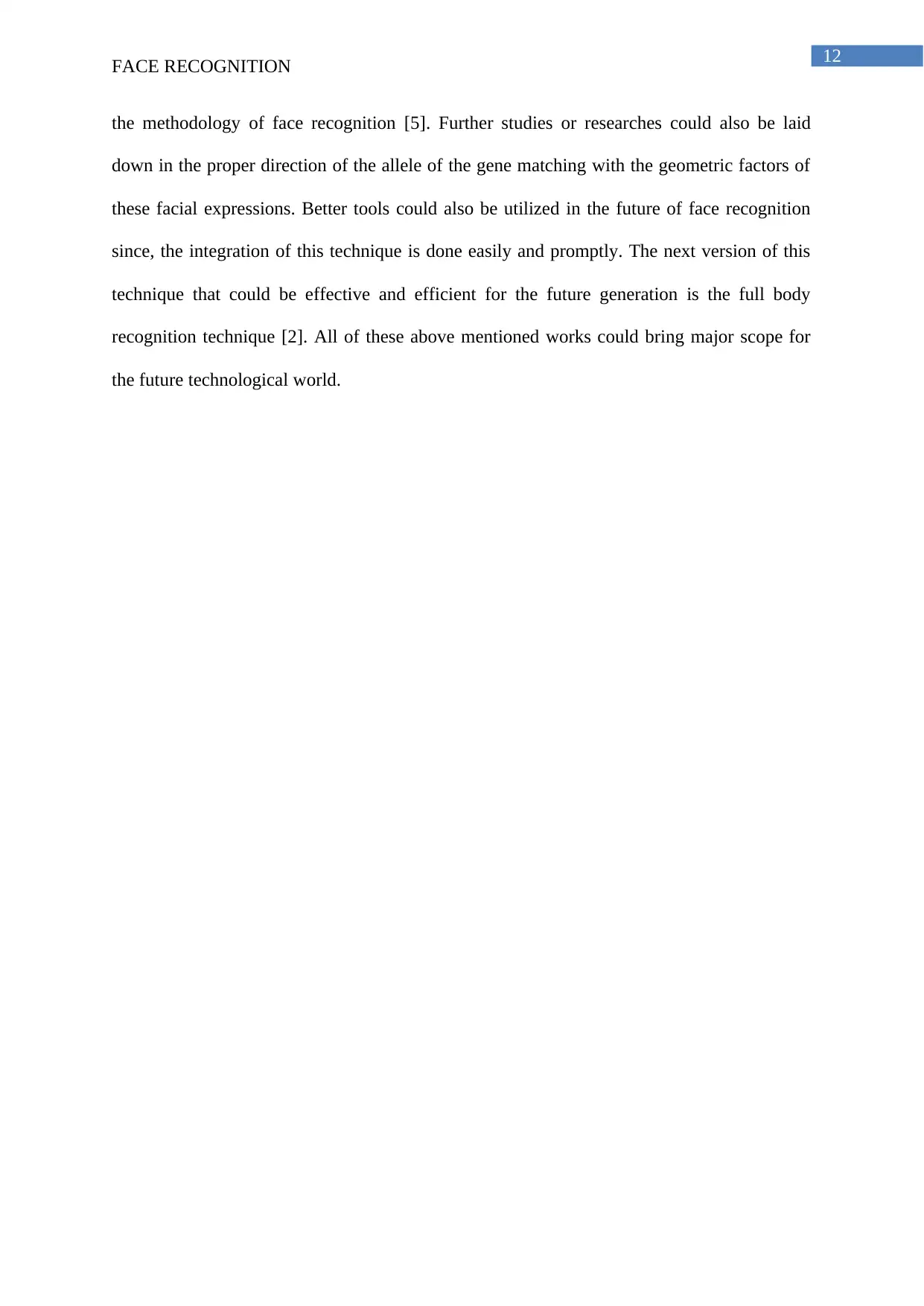
12
FACE RECOGNITION
the methodology of face recognition [5]. Further studies or researches could also be laid
down in the proper direction of the allele of the gene matching with the geometric factors of
these facial expressions. Better tools could also be utilized in the future of face recognition
since, the integration of this technique is done easily and promptly. The next version of this
technique that could be effective and efficient for the future generation is the full body
recognition technique [2]. All of these above mentioned works could bring major scope for
the future technological world.
FACE RECOGNITION
the methodology of face recognition [5]. Further studies or researches could also be laid
down in the proper direction of the allele of the gene matching with the geometric factors of
these facial expressions. Better tools could also be utilized in the future of face recognition
since, the integration of this technique is done easily and promptly. The next version of this
technique that could be effective and efficient for the future generation is the full body
recognition technique [2]. All of these above mentioned works could bring major scope for
the future technological world.
Paraphrase This Document
Need a fresh take? Get an instant paraphrase of this document with our AI Paraphraser
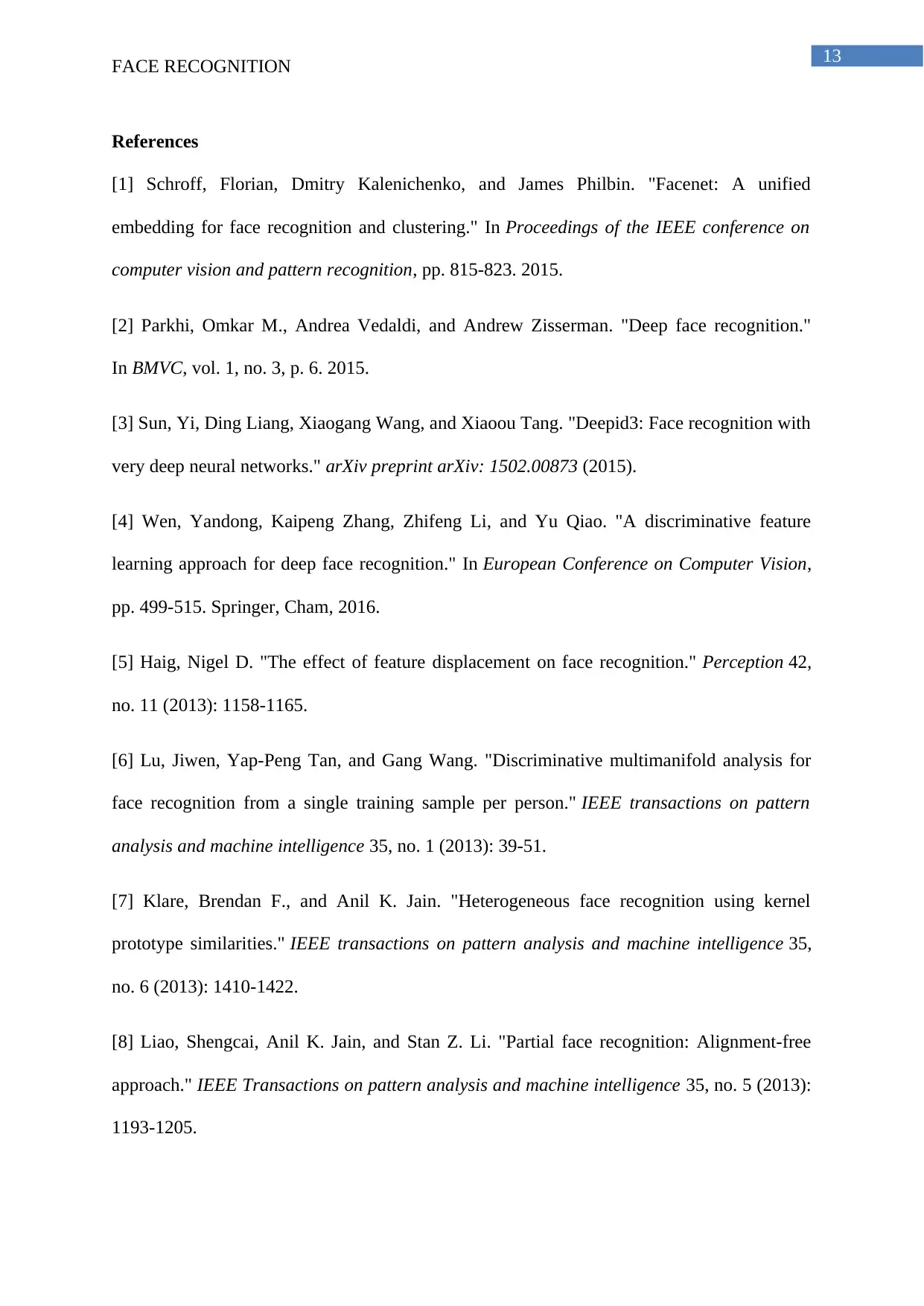
13
FACE RECOGNITION
References
[1] Schroff, Florian, Dmitry Kalenichenko, and James Philbin. "Facenet: A unified
embedding for face recognition and clustering." In Proceedings of the IEEE conference on
computer vision and pattern recognition, pp. 815-823. 2015.
[2] Parkhi, Omkar M., Andrea Vedaldi, and Andrew Zisserman. "Deep face recognition."
In BMVC, vol. 1, no. 3, p. 6. 2015.
[3] Sun, Yi, Ding Liang, Xiaogang Wang, and Xiaoou Tang. "Deepid3: Face recognition with
very deep neural networks." arXiv preprint arXiv: 1502.00873 (2015).
[4] Wen, Yandong, Kaipeng Zhang, Zhifeng Li, and Yu Qiao. "A discriminative feature
learning approach for deep face recognition." In European Conference on Computer Vision,
pp. 499-515. Springer, Cham, 2016.
[5] Haig, Nigel D. "The effect of feature displacement on face recognition." Perception 42,
no. 11 (2013): 1158-1165.
[6] Lu, Jiwen, Yap-Peng Tan, and Gang Wang. "Discriminative multimanifold analysis for
face recognition from a single training sample per person." IEEE transactions on pattern
analysis and machine intelligence 35, no. 1 (2013): 39-51.
[7] Klare, Brendan F., and Anil K. Jain. "Heterogeneous face recognition using kernel
prototype similarities." IEEE transactions on pattern analysis and machine intelligence 35,
no. 6 (2013): 1410-1422.
[8] Liao, Shengcai, Anil K. Jain, and Stan Z. Li. "Partial face recognition: Alignment-free
approach." IEEE Transactions on pattern analysis and machine intelligence 35, no. 5 (2013):
1193-1205.
FACE RECOGNITION
References
[1] Schroff, Florian, Dmitry Kalenichenko, and James Philbin. "Facenet: A unified
embedding for face recognition and clustering." In Proceedings of the IEEE conference on
computer vision and pattern recognition, pp. 815-823. 2015.
[2] Parkhi, Omkar M., Andrea Vedaldi, and Andrew Zisserman. "Deep face recognition."
In BMVC, vol. 1, no. 3, p. 6. 2015.
[3] Sun, Yi, Ding Liang, Xiaogang Wang, and Xiaoou Tang. "Deepid3: Face recognition with
very deep neural networks." arXiv preprint arXiv: 1502.00873 (2015).
[4] Wen, Yandong, Kaipeng Zhang, Zhifeng Li, and Yu Qiao. "A discriminative feature
learning approach for deep face recognition." In European Conference on Computer Vision,
pp. 499-515. Springer, Cham, 2016.
[5] Haig, Nigel D. "The effect of feature displacement on face recognition." Perception 42,
no. 11 (2013): 1158-1165.
[6] Lu, Jiwen, Yap-Peng Tan, and Gang Wang. "Discriminative multimanifold analysis for
face recognition from a single training sample per person." IEEE transactions on pattern
analysis and machine intelligence 35, no. 1 (2013): 39-51.
[7] Klare, Brendan F., and Anil K. Jain. "Heterogeneous face recognition using kernel
prototype similarities." IEEE transactions on pattern analysis and machine intelligence 35,
no. 6 (2013): 1410-1422.
[8] Liao, Shengcai, Anil K. Jain, and Stan Z. Li. "Partial face recognition: Alignment-free
approach." IEEE Transactions on pattern analysis and machine intelligence 35, no. 5 (2013):
1193-1205.
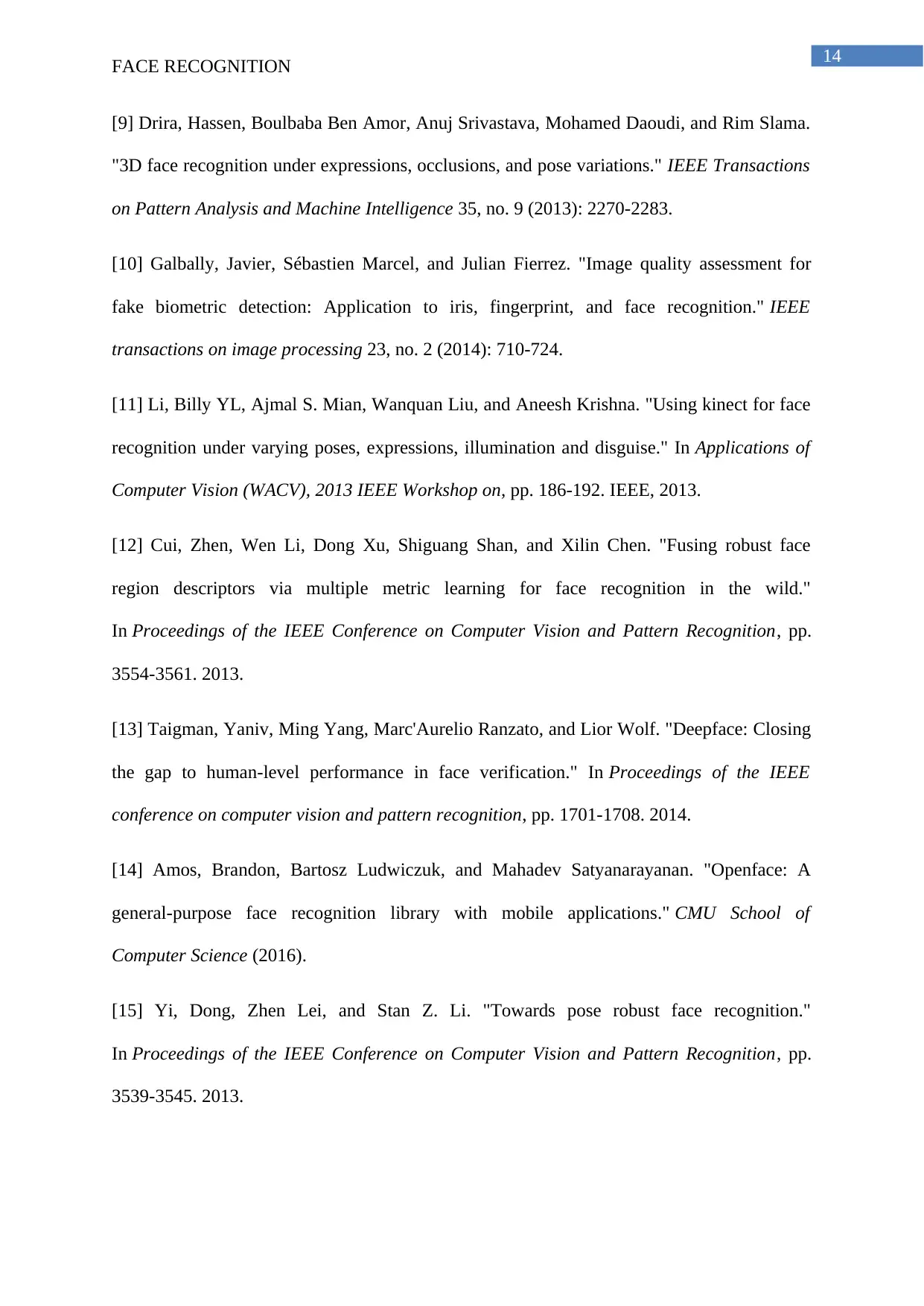
14
FACE RECOGNITION
[9] Drira, Hassen, Boulbaba Ben Amor, Anuj Srivastava, Mohamed Daoudi, and Rim Slama.
"3D face recognition under expressions, occlusions, and pose variations." IEEE Transactions
on Pattern Analysis and Machine Intelligence 35, no. 9 (2013): 2270-2283.
[10] Galbally, Javier, Sébastien Marcel, and Julian Fierrez. "Image quality assessment for
fake biometric detection: Application to iris, fingerprint, and face recognition." IEEE
transactions on image processing 23, no. 2 (2014): 710-724.
[11] Li, Billy YL, Ajmal S. Mian, Wanquan Liu, and Aneesh Krishna. "Using kinect for face
recognition under varying poses, expressions, illumination and disguise." In Applications of
Computer Vision (WACV), 2013 IEEE Workshop on, pp. 186-192. IEEE, 2013.
[12] Cui, Zhen, Wen Li, Dong Xu, Shiguang Shan, and Xilin Chen. "Fusing robust face
region descriptors via multiple metric learning for face recognition in the wild."
In Proceedings of the IEEE Conference on Computer Vision and Pattern Recognition, pp.
3554-3561. 2013.
[13] Taigman, Yaniv, Ming Yang, Marc'Aurelio Ranzato, and Lior Wolf. "Deepface: Closing
the gap to human-level performance in face verification." In Proceedings of the IEEE
conference on computer vision and pattern recognition, pp. 1701-1708. 2014.
[14] Amos, Brandon, Bartosz Ludwiczuk, and Mahadev Satyanarayanan. "Openface: A
general-purpose face recognition library with mobile applications." CMU School of
Computer Science (2016).
[15] Yi, Dong, Zhen Lei, and Stan Z. Li. "Towards pose robust face recognition."
In Proceedings of the IEEE Conference on Computer Vision and Pattern Recognition, pp.
3539-3545. 2013.
FACE RECOGNITION
[9] Drira, Hassen, Boulbaba Ben Amor, Anuj Srivastava, Mohamed Daoudi, and Rim Slama.
"3D face recognition under expressions, occlusions, and pose variations." IEEE Transactions
on Pattern Analysis and Machine Intelligence 35, no. 9 (2013): 2270-2283.
[10] Galbally, Javier, Sébastien Marcel, and Julian Fierrez. "Image quality assessment for
fake biometric detection: Application to iris, fingerprint, and face recognition." IEEE
transactions on image processing 23, no. 2 (2014): 710-724.
[11] Li, Billy YL, Ajmal S. Mian, Wanquan Liu, and Aneesh Krishna. "Using kinect for face
recognition under varying poses, expressions, illumination and disguise." In Applications of
Computer Vision (WACV), 2013 IEEE Workshop on, pp. 186-192. IEEE, 2013.
[12] Cui, Zhen, Wen Li, Dong Xu, Shiguang Shan, and Xilin Chen. "Fusing robust face
region descriptors via multiple metric learning for face recognition in the wild."
In Proceedings of the IEEE Conference on Computer Vision and Pattern Recognition, pp.
3554-3561. 2013.
[13] Taigman, Yaniv, Ming Yang, Marc'Aurelio Ranzato, and Lior Wolf. "Deepface: Closing
the gap to human-level performance in face verification." In Proceedings of the IEEE
conference on computer vision and pattern recognition, pp. 1701-1708. 2014.
[14] Amos, Brandon, Bartosz Ludwiczuk, and Mahadev Satyanarayanan. "Openface: A
general-purpose face recognition library with mobile applications." CMU School of
Computer Science (2016).
[15] Yi, Dong, Zhen Lei, and Stan Z. Li. "Towards pose robust face recognition."
In Proceedings of the IEEE Conference on Computer Vision and Pattern Recognition, pp.
3539-3545. 2013.
⊘ This is a preview!⊘
Do you want full access?
Subscribe today to unlock all pages.

Trusted by 1+ million students worldwide
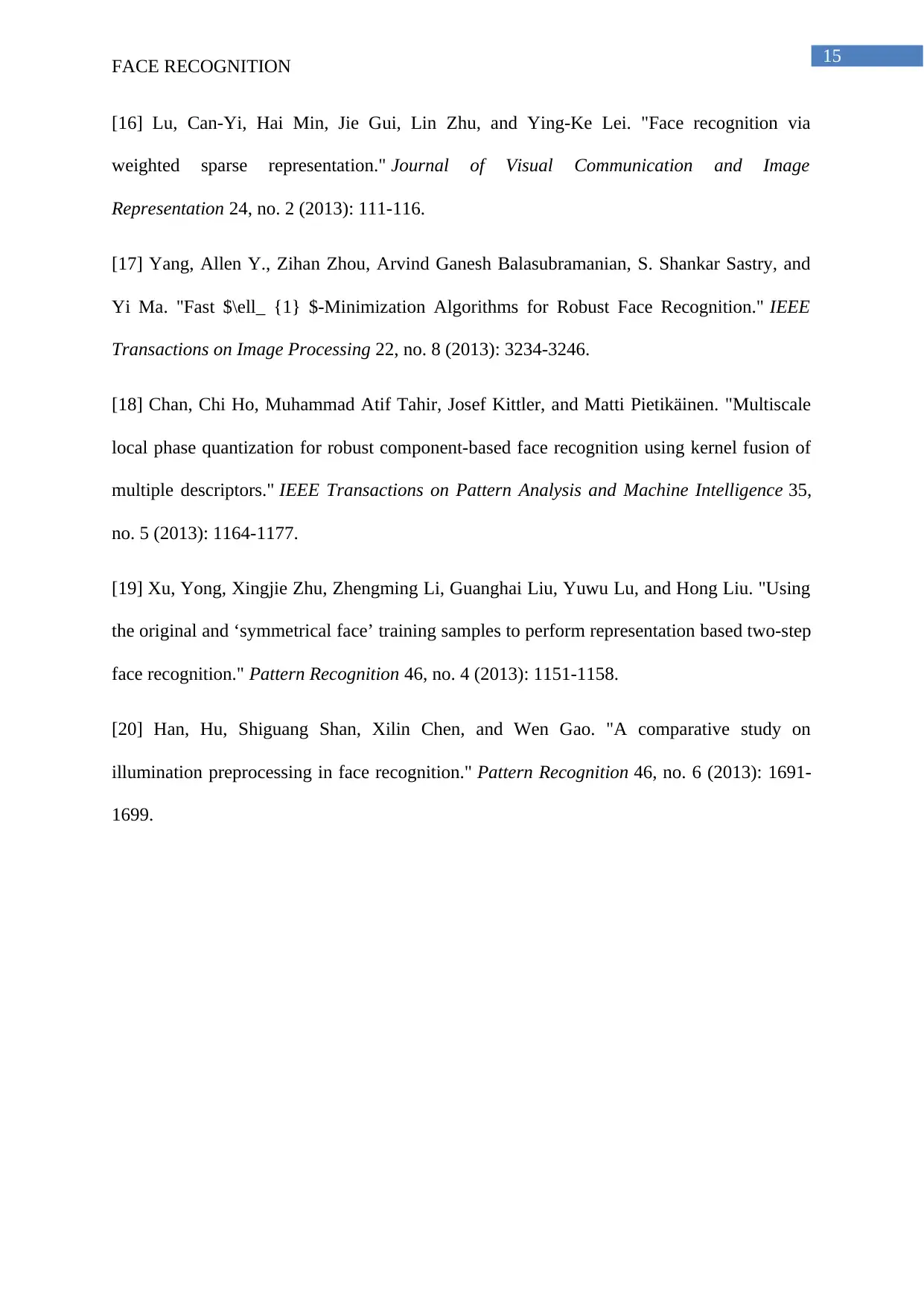
15
FACE RECOGNITION
[16] Lu, Can-Yi, Hai Min, Jie Gui, Lin Zhu, and Ying-Ke Lei. "Face recognition via
weighted sparse representation." Journal of Visual Communication and Image
Representation 24, no. 2 (2013): 111-116.
[17] Yang, Allen Y., Zihan Zhou, Arvind Ganesh Balasubramanian, S. Shankar Sastry, and
Yi Ma. "Fast $\ell_ {1} $-Minimization Algorithms for Robust Face Recognition." IEEE
Transactions on Image Processing 22, no. 8 (2013): 3234-3246.
[18] Chan, Chi Ho, Muhammad Atif Tahir, Josef Kittler, and Matti Pietikäinen. "Multiscale
local phase quantization for robust component-based face recognition using kernel fusion of
multiple descriptors." IEEE Transactions on Pattern Analysis and Machine Intelligence 35,
no. 5 (2013): 1164-1177.
[19] Xu, Yong, Xingjie Zhu, Zhengming Li, Guanghai Liu, Yuwu Lu, and Hong Liu. "Using
the original and ‘symmetrical face’ training samples to perform representation based two-step
face recognition." Pattern Recognition 46, no. 4 (2013): 1151-1158.
[20] Han, Hu, Shiguang Shan, Xilin Chen, and Wen Gao. "A comparative study on
illumination preprocessing in face recognition." Pattern Recognition 46, no. 6 (2013): 1691-
1699.
FACE RECOGNITION
[16] Lu, Can-Yi, Hai Min, Jie Gui, Lin Zhu, and Ying-Ke Lei. "Face recognition via
weighted sparse representation." Journal of Visual Communication and Image
Representation 24, no. 2 (2013): 111-116.
[17] Yang, Allen Y., Zihan Zhou, Arvind Ganesh Balasubramanian, S. Shankar Sastry, and
Yi Ma. "Fast $\ell_ {1} $-Minimization Algorithms for Robust Face Recognition." IEEE
Transactions on Image Processing 22, no. 8 (2013): 3234-3246.
[18] Chan, Chi Ho, Muhammad Atif Tahir, Josef Kittler, and Matti Pietikäinen. "Multiscale
local phase quantization for robust component-based face recognition using kernel fusion of
multiple descriptors." IEEE Transactions on Pattern Analysis and Machine Intelligence 35,
no. 5 (2013): 1164-1177.
[19] Xu, Yong, Xingjie Zhu, Zhengming Li, Guanghai Liu, Yuwu Lu, and Hong Liu. "Using
the original and ‘symmetrical face’ training samples to perform representation based two-step
face recognition." Pattern Recognition 46, no. 4 (2013): 1151-1158.
[20] Han, Hu, Shiguang Shan, Xilin Chen, and Wen Gao. "A comparative study on
illumination preprocessing in face recognition." Pattern Recognition 46, no. 6 (2013): 1691-
1699.
1 out of 16
Related Documents
Your All-in-One AI-Powered Toolkit for Academic Success.
+13062052269
info@desklib.com
Available 24*7 on WhatsApp / Email
![[object Object]](/_next/static/media/star-bottom.7253800d.svg)
Unlock your academic potential
© 2024 | Zucol Services PVT LTD | All rights reserved.





